28.05.18
Isle of Jura New Range – Very Far from Ordinary
Interview with Blender/Whiskymaker, Gregg Glass and Global Head of Brand, Kirsteen Beeston
Jura’s new Signature Series range was launched earlier in the spring this year. An interview with the two people with major responsibility for launch and the new range took a few weeks to get together. These are very busy people!
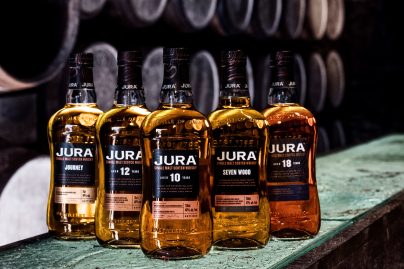 From both I wanted to know about the impetus behind the change in the range. From Gregg I was interested to know what characteristics, if anything, of the previous range they wanted to keep; why the introduction of more smokiness; why the subtle strength difference for Seven Wood and 18 Year Old; more about the wood types used and future liquid plans. On a personal note I was curious as to what enticed him away from Compass Box; what is he learning here that he didn’t at CB and what was the influence of Master Blender, Richard Paterson.
From both I wanted to know about the impetus behind the change in the range. From Gregg I was interested to know what characteristics, if anything, of the previous range they wanted to keep; why the introduction of more smokiness; why the subtle strength difference for Seven Wood and 18 Year Old; more about the wood types used and future liquid plans. On a personal note I was curious as to what enticed him away from Compass Box; what is he learning here that he didn’t at CB and what was the influence of Master Blender, Richard Paterson.
So where did the impetus for the new range come from – blending or marketing? Both Kirsteen and Gregg indicated separately that it was a rather serendipitous combination of the two. When Gregg joined from Compass Box in December 2016 there was a review of the Jura offering already in process. They were looking at a new 10 Year Old option for the US and wondering how to build up the range for the rest of the world. Gregg states, “ We also needed a strong, clear identity for Jura in the future.”
They were also trying to give out a solid message about what Jura is and for Gregg both of those things are a Jura which 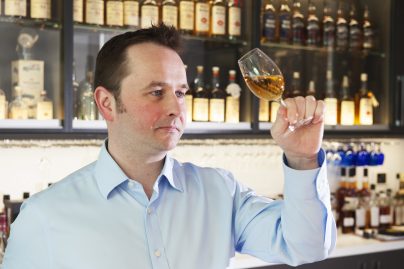 “retains its freshness and fruity qualities with subtle, soft, clean smoke at the back. NOT a smoky style. Its heart and soul is a fresh Highland & Island character but a focus on what Delme Evans [designer and first manager of the newly revived distillery] wanted in the beginning when the distillery was rebuilt in the early 1960’s. We retain the beauty of character of Jura but there’s a red line of subtle smoke, like a seasoning.” So a bit like that salt or citrus lift so often referred to on Masterchef! It’s true, though. The new expressions have exactly that.
“retains its freshness and fruity qualities with subtle, soft, clean smoke at the back. NOT a smoky style. Its heart and soul is a fresh Highland & Island character but a focus on what Delme Evans [designer and first manager of the newly revived distillery] wanted in the beginning when the distillery was rebuilt in the early 1960’s. We retain the beauty of character of Jura but there’s a red line of subtle smoke, like a seasoning.” So a bit like that salt or citrus lift so often referred to on Masterchef! It’s true, though. The new expressions have exactly that.
Gregg goes on to say they have set no limits for themselves and there are different degrees of smoke in each one but all are subtle and sometimes sherry helps to accent the smoke. I’d say that’s certainly the case with the new 12 Year Old which, to me, was the smokiest, from US oak ex-bourbon cask and then some time in oloroso sherry wood – but far from what its neighbours over the water on Islay produce. The new Jura focus is on versatility and openness of style.
Certainly the team at Whyte & Mackay are clear that US white oak is the perfect partner for Jura’s main maturation as it has been for years. In general the spirit spends most of its life in this and it’s then re-racked into its finishing wood (if used) ideally for at least a couple of years. Normal practice for them is to combine aged unpeated and aged peated whisky and then return it to the wood for a while longer. It seems any whisky being finished is the unpeated which is then combined with the peated before further marrying. They want to create something which is their interpretation of the true nature of Jura – elegance, fruit, citrus and vanilla. Peated spirit at Jura is still a very small part of the production, made for only two weeks each year so they don’t want to emphasise the peat story. It’s a subtlety, not a goal.
Looking further at the wood, it transpires that some of the casks were laid down by Richard Paterson in the past and which now have a home. For example, Seven Wood started as a wood experiment years ago. The team decided it wanted to talk about the flavour impact of wood and there are two key ones – oak from the Vosges (milk chocolate, coffee and citrus) and from Bertanges (tropical fruits and grass). Other oaks used are from Jupilles, Troncais, Limoges, Allier and, of course, the USA. They look at seasoning and toasting/charring. As Gregg states, “There’s a lot to play with and it helps with telling the story of the Jura character and where those characteristics come from.” The wood aspect of whisky maturation is fascinating and gives so much scope. Some of the oak used is virgin oak but it is simply charred to the required depth and then filled. A variety of char levels is used.
On my question as to why the subtle difference in alcohol level in Seven Wood (42%) and 18 Year Old (44%) from the rest of the core range, the answer is simply what tasted best and accentuated the character and intensity of flavour. I asked what red wine casks were used in maturing 18YO but was told only that they are from Premier and Grand Cru wines. Well, there has to be some mystery!
I asked also about older spirit. As the distillery was rebuilt in the early 1960’s I thought there may not be any really old spirit there if a lot had been used for blending in the early days. According to Gregg, there are some older casks and some really exciting creations to come within their house style parameters. There isn’t much older peated stock and not much Jura is used in the Whyte & Mackay blend. One thing the team is keen to stress is that education is needed to let consumers not be afraid of the no age statement concept and to focus on the flavour of the whisky as a key driver of quality. In Seven Wood, the natural properties of what the oak is bringing helps here and there is “ a need to big up the innovation story.” Try Seven Wood – it’s delightful (tasting note below).
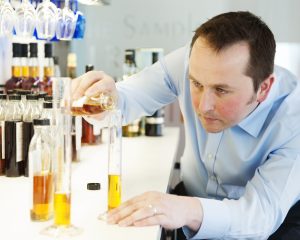 On a personal level, Gregg Glass had a happy ten years at Compass Box. “Working with John Glaser was fascinating and the creative spin was great”, Gregg relates. However, he also now gets that at Whyte & Mackay and one major attraction is that there are a lot more whisky “tools” to play with. bigger paint box, if you like. From a creative point here, there’s also a lot of drive to let the blenders develop interesting things. For example, some cask types have no homes yet, “But they will!” promises Gregg. Be assured this is no exercise in shoehorning casks into something just to use them. There is painstaking method and focused purpose behind it all, to produce high quality expressions which will charm the consumer. They are doing a lot of work on wood types and from unusual places but for flavour reasons.
On a personal level, Gregg Glass had a happy ten years at Compass Box. “Working with John Glaser was fascinating and the creative spin was great”, Gregg relates. However, he also now gets that at Whyte & Mackay and one major attraction is that there are a lot more whisky “tools” to play with. bigger paint box, if you like. From a creative point here, there’s also a lot of drive to let the blenders develop interesting things. For example, some cask types have no homes yet, “But they will!” promises Gregg. Be assured this is no exercise in shoehorning casks into something just to use them. There is painstaking method and focused purpose behind it all, to produce high quality expressions which will charm the consumer. They are doing a lot of work on wood types and from unusual places but for flavour reasons.
Another reason was to work with Richard Paterson and learn even more. “Richard Paterson’s mind is amazing.” The focus is on whisky making and , “To make democratically great whisky. Something like Jura Journey – so versatile – and onwards on a scale of beautiful, elegant and affordable up to one-offs and limited editions.” Being able to bring unusual flavours to people was also an opportunity to reach a larger audience.
Not being able to get them in the same room at the same time, my next chat was with Kirsteen Beeston, Marketing Director for Isle of Jura. She’s a lady of considerable senior marketing experience whom I first met when she was at Morrison Bowmore as was, before moving on to Edrington for a while and, since June 2017, at Whyte & Mackay.
Kirsteen confirmed the several years’ gestation of the project. Her analysis is that the portfolio was fragmented which was challenging for management of spirit stocks yet points out  their whisky stocks are the envy of many due to Richard Paterson. The team had an eye on growth and had to think of a stock model for that growth also with an eye on existing availability. Anyway, the previous range of Jura didn’t allow for that growth. It was also not conducive to acquiring new consumers. It was hard to make sense of what Jura is. The proposition didn’t give the team the chance to tell the bigger island and distillery story.
their whisky stocks are the envy of many due to Richard Paterson. The team had an eye on growth and had to think of a stock model for that growth also with an eye on existing availability. Anyway, the previous range of Jura didn’t allow for that growth. It was also not conducive to acquiring new consumers. It was hard to make sense of what Jura is. The proposition didn’t give the team the chance to tell the bigger island and distillery story.
Apart from the new range there are plans for limited and permanent editions to the new core range. There are stocks going back to the 70’s and they are currently looking at how to utilise and introduce casks from the 1980’s. The new travel retail range highlights the ingenuity of wood policy and the subtleties of using different ages of PX sherry-casked whisky. As my car was on a meter and I’d chatted with Gregg for longer than expected, I had time only to nose the travel retail range and they were certainly enticing, but then I love a good sherry cask.
Kirsteen explained one big challenge is in getting across on pack the educational information as well as the whisky-making experience and craftsmanship that goes into making Isle of Jura. Yes, craftsmanship. I’m delighted she used the word. Let’s note that craftsmanship applies to all distilleries, large or small, multi-national or tiny single distillery, computers or not. It’s a human with experience who makes the decisions. At Jura it is this craftsmanship, ingenuity and determination from those on the island producing it and the whisky-making expertise that are personified in the spirit.
I wondered what, if anything the team felt Jura did not have/do vis-à-vis its competition. Why did they feel the need to change the range? Jura does, after all, have plenty of fans, though it was still a smaller brand. Kirsteen explained that, from a whisky profile viewpoint, there is more richness, depth and complexity now to give interest versus the mainstays of the category and give the consumer a level of confidence and reassurance. The spirit they make and mature has not changed, it’s just the way it’s put together from the array of great casks. There was a need to explain the whisky in a way to help consumers understand it better. That new positioning is “A Long Way from Ordinary.” Indeed, what about its previous positioning – anyone remember what it was? I don’t. Point taken.
Kirsteen reasserts that the new style is sweet and subtly smoky, crafted by the island and its people. The “Long Way from Ordinary “ theme is geographical but also based on a unique community which sets it apart as well as a whisky style which is a long way from ordinary. Kirsteen reiterated Gregg’s assertion that it is a coming together of Highland and Island styles, with the best of both. Indeed, having tasted all five new expressions, I feel the new core range is more…unified is the only word I can think of. More integrated as a range, maybe. It’s more of a progression through the five offerings, two of which are NAS and can defy any naysayers who think an age statement is the determining factor in whisky quality. Much as I liked the previous expressions, it did feel like a small, limited range with a peaty one (Superstition) tacked on to show they could do that too. The new range shows there are no limits with the blenders given the appropriate freedoms. I was a big fan of Jura 16 YO (Diurach’s Own) but the new expressions more than make up for its loss.
In explaining that Whyte & Mackay are thinking about growth and brand building for the future she related how a new distribution relationship was created in the US where Jura sold 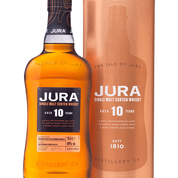 only about 12,000 cases. Distributor Gallo indicated that if they were serious about growth they needed to develop “a different approach to engage and excite the distribution network.” Therefore it was decided to test a new 10 year old product, pack and communication which was researched in the US, UK, Taiwan, France and Germany. It was a test to see how this new house style performed. It surpassed expectations from both trade and consumers in terms of its flavour profile. Both 10 Year Old and the NAS entry expression, Jura Journey, are aimed at grocery retail category as there is sufficient volume. 12 Year Old is available globally but channelled into specialist retailers and on-trade as there is not enough stock, currently, for the larger channels.
only about 12,000 cases. Distributor Gallo indicated that if they were serious about growth they needed to develop “a different approach to engage and excite the distribution network.” Therefore it was decided to test a new 10 year old product, pack and communication which was researched in the US, UK, Taiwan, France and Germany. It was a test to see how this new house style performed. It surpassed expectations from both trade and consumers in terms of its flavour profile. Both 10 Year Old and the NAS entry expression, Jura Journey, are aimed at grocery retail category as there is sufficient volume. 12 Year Old is available globally but channelled into specialist retailers and on-trade as there is not enough stock, currently, for the larger channels.
So I certainly wish them good fortune with these new offerings. Not only are they encouraging people to drink them neat/with water but also in cocktails as I witnessed at the Glasgow launch in April where the Jura Sundowner using 10YO was just one great hit that night. And now for the Jura Seven Wood tasting note, as promised.
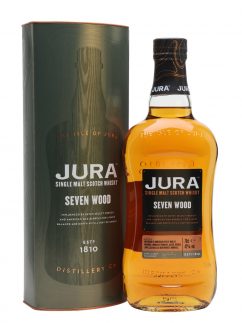 Jura Seven Wood – 42% abv
Jura Seven Wood – 42% abv
From seven types of oak from selected French oaks and first fill US ex-bourbon wood.
Appearance: Rich, old gold with brass glints Tears are very slow to form and quite wide both at first and in follow-up. An impression of unctiosness and higher viscosity.
Nose: needs a little while to open out. It’s creamier than others tasted in the range. Some oak vanilla. The smoke is hardly detectable at first, it’s so subtle. Some light sultana and dried stone fruits. Floral notes – maybe orange blossom? A slight waft of minty freshness also. Then the smoke quietly insinuates its way through. With water, it’s more richly fruity and with some caramel notes; warm polished wood and light spices like mace. Left to sit it a short while goes a bit quiet then bounces back with new notes of apricot flan. Nosing the empty glass afterwards there was plenty of rich, dried fruits and apricot/peach notes.
Palate: A slightly luscious and oily mouth feel, sweet spices, citrus peel and some pepper. Some lightly astringent oak tannins and citrus oil bitterness at the end.
Finish: This is long, herbal with some pepper, dryness and a ribbon of smoke.
Indeed, all the new expressions are a delight. I could happily nose these all day.
CD – 25/5/2018
Comments